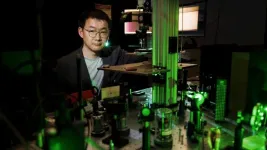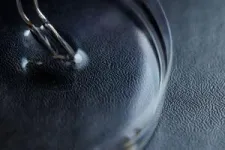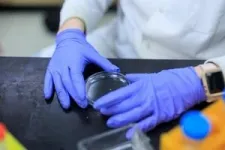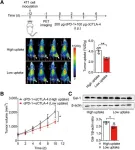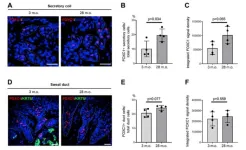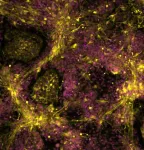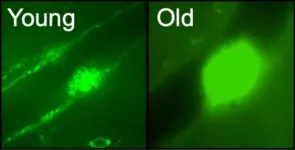(Press-News.org) Metal halide perovskites have emerged in recent years as a low-cost, highly efficient semiconducting material for solar energy, solid-state lighting and more. Despite their growing use, a fundamental understanding of the origins of their outstanding properties is still lacking. A Husker scientist is aiming to find answers that could lead to the development of new materials and new applications.
Yinsheng Guo, assistant professor of chemistry at the University of Nebraska–Lincoln, also wants to transform how physical chemistry is taught to undergraduate and graduate students, who often struggle to understand and apply what they have learned in class to the laboratory and STEM workplace.
Guo’s research and teaching project is funded by a five-year, $648,335 grant from the National Science Foundation’s Faculty Early Career Development Program.
“The importance of photovoltaic technology in the energy portfolio will continue to grow globally and in the U.S.,” Guo said. “Such growth is fueled by the continuous investment and innovation in new technologies.”
Metal halide perovskites (or MHPs), which “have become a star material in the last decade,” represent a major branch of these technologies. Perovskites are a group of materials that have distinctive crystal structures of interconnected octahedral units made of metal and oxide or halide ions. The broadly defined perovskite family is known for its superconducting and ferroelectric properties, drawing interest in both fundamental science and materials engineering. As scientists have learned more about MHPs’ ability to absorb and emit photons of light and be used for harvesting electricity, perovskites have emerged as a much less expensive, easier to scale up alternative to silicon for use in energy technologies.
MHPs can be used as semiconducting materials in a variety of applications, including solar energy, solid-state lighting, lasers, photodetectors and general optoelectronic applications, Guo said.
However, Guo said, “a comprehensive and consistent understanding of the origin of the many outstanding optoelectronic properties is still lacking despite being intensively pursued.” His research goal is to answer fundamental questions about MHPs.
MHPs’ exceptional performance is surprising, given that they are defect-prone, low-temperature, solution-processed materials, Guo said. He and his research team will work to quantify and control MHPs’ unique structural dynamics to better understand their exceptional electronic properties so they can be further developed and commercialized.
Ultimately, a better understanding of MHPs’ design principles could be useful in developing other emerging materials.
Guo also aims to change how students approach physical chemistry.
“Chemistry is the central science and serves as the physical foundation for advancements in both biomedical and material fields,” Guo said. “A good conceptual understanding of the physical and chemical principles enables and empowers a future science, technology, engineering and mathematics workforce.”
As a teacher, Guo said, he has observed that both undergraduate and graduate students struggle with that conceptual understanding, which may be exacerbated by differences in how students learned about physical sciences earlier on.
“Students’ learning is often compartmentalized,” Guo said. “Undergraduate students often assume an exam-oriented mentality and do not find the course content and skills transferrable in their career and life; graduate students often are challenged to transfer course content into research skills.”
Through his CAREER project, Guo will develop a computational and experiential approach to address the challenges of teaching and learning physical chemistry. Guo said he will harness readily available computational resources to break down the learning barrier and bring students toward better conceptual understanding through active, experiential learning.
Computational literacy is also an important element for the next generation entering the STEM workforce at a time when machine intelligence plays an indispensable role. Having built a computational skillset, students will be guided to further explore scientific data, including mapping spectra — a visual representation of the intensity of light — to musical notes. The idea is to produce molecularly encoded music as a bridge between science and art.
The National Science Foundation’s CAREER award supports pre-tenure faculty who exemplify the role of teacher-scholars through outstanding research, excellent education and the integration of education and research.
END
Lessons in chemistry: Guo aims at fundamental understanding of emerging semiconductor material
NSF provides early career award to support chemist's research and teaching
2024-05-14
ELSE PRESS RELEASES FROM THIS DATE:
Newly identified PET biomarker predicts success of immune checkpoint blockade therapy
2024-05-14
Reston, VA—The protein galectin-1 (Gal-1) has been identified as a new PET imaging biomarker for immune checkpoint blockade (ICB) therapy, allowing physicians to predict the tumor responses before beginning treatment. Information garnered from Gal-1 PET imaging could also be used to facilitate patient stratification and optimize immunotherapy, enabling targeted interventions and improving patient outcomes. This research was published in the May issue of The Journal of Nuclear Medicine.
Immunotherapies, such as ICB, have produced promising clinical ...
Age-associated gene expression changes in mouse sweat glands
2024-05-14
“In this study, we first obtained evidence that, in mouse, aging primarily reduced the number of active sweat glands.”
BUFFALO, NY- May 14, 2024 – A new research paper was published in Aging (listed by MEDLINE/PubMed as "Aging (Albany NY)" and "Aging-US" by Web of Science) Volume 16, Issue 8, entitled, “Characterization of age-associated gene expression changes in mouse sweat glands.”
Evaporation of sweat on the skin surface is the major mechanism for dissipating heat in humans. The secretory capacity of sweat glands (SWGs) ...
26-year-old heart transplant and stroke survivor named national champion for women’s health
2024-05-14
DALLAS, May 13, 2024 — Fewer than half of all women are aware that heart disease is their leading cause of death. That is why the American Heart Association, celebrating one hundred years of lifesaving service, created its community-based Woman of Impact™ initiative as an outgrowth of its year-round Go Red for Women® activist movement. The movement spotlights the lack of awareness and the clinical care gaps in women’s heart health. This year’s National Winner of the Go Red for Women 2024 Woman of Impart initiative is a 26-year-old heart transplant recipient, stroke survivor and American Heart Association local volunteer, Hana Hooper from Puget ...
Virus that causes COVID-19 can penetrate blood-retinal-barrier and could damage vision
2024-05-14
The blood-retinal barrier is designed to protect our vision from infections by preventing microbial pathogens from reaching the retina where they could trigger an inflammatory response with potential vision loss. But researchers at the University of Missouri School of Medicine have discovered the virus that causes COVID-19 can breach this protective retinal barrier with potential long-term consequences in the eye.
Pawan Kumar Singh, PhD, an assistant professor of ophthalmology, leads a team researching new ways to prevent and treat ocular infectious diseases. Using a humanized ...
Stem cells provide new insight into genetic pathway of childhood cancer
2024-05-14
Scientists have discovered a new insight into the genetic pathway of childhood cancer, offering new hope for tailored treatments.
Researchers from the University of Sheffield have created a stem cell model designed to investigate the origins of neuroblastoma, a cancer primarily affecting babies and young children.
Neuroblastoma is the most common childhood tumour occurring outside the brain, affecting the lives of approximately 600 children in the European Union and the United Kingdom each year.
Until now, studying genetic changes and their role in neuroblastoma initiation has been challenging due to the lack of suitable laboratory ...
Distinct population of ‘troublemaker’ platelet cells appear with aging, lead to blood clotting, disease
2024-05-14
As people age, they become more prone to blood clotting diseases, when blood cells called platelets clump together when they don’t need to and can cause major issues such as strokes and cardiovascular disease. For decades, scientists have studied why older people’s blood cells behave in this way, using their insights to develop the myriad of blood-thinning drugs now on the market for treating the leading cause of death in the United States.
Now, UC Santa Cruz Professor of Biomolecular Engineering Camilla Forsberg and her research group have ...
2023 was the hottest summer in two thousand years
2024-05-14
Researchers have found that 2023 was the hottest summer in the Northern Hemisphere in the past two thousand years, almost four degrees warmer than the coldest summer during the same period.
Although 2023 has been reported as the hottest year on record, the instrumental evidence only reaches back as far as 1850 at best, and most records are limited to certain regions.
Now, by using past climate information from annually resolved tree rings over two millennia, scientists from the University of Cambridge and the Johannes Gutenberg University Mainz have shown how exceptional the summer of 2023 was.
Even allowing for natural climate variations over hundreds of years, 2023 was still ...
Analysis of previously unstudied areas of the human genome suggests people with more copies of ribosomal DNA have higher risks of developing disease
2024-05-14
UNDER STRICT EMBARGO UNTIL 4PM GMT (11AM ET) on 14 May 2024.
Peer reviewed | Observational | People
Ribosomal DNA (rDNA) is present in hundreds of copies in the genome, but has not previously been part of genetic analyses. A new study of 500,000 individuals indicates that people who have more copies of rDNA are more likely to develop inflammation and diseases during their lifetimes.
Standard genetic analysis techniques have not studied areas of the human genome that are repetitive, such as ribosomal ...
Study reveals mixed public opinion on polygenic embryo screening for IVF
2024-05-14
Three out of four U.S. adults support the use of emerging technologies that estimate a future child’s likelihood of developing health conditions influenced by multiple genes — such as diabetes, heart disease, and depression — before an embryo is implanted during in vitro fertilization (IVF), according to a new public opinion survey led by researchers at Harvard Medical School.
Results of the survey, to be published May 14 in JAMA Network Open, underscore the need for public education and conversation about the positive ...
Congenital anomalies are ten times more frequent in children with neurodevelopmental disorders
2024-05-14
Children with neurodevelopmental disorders report congenital abnormalities, such as defects of the heart and/or urinary tract, at least ten times more frequent compared to other children. This is one of the findings from an analysis from Radboud university medical center of data from over 50,000 children. Thanks to this new database, it's now much clearer which health problems are associated with a particular neurodevelopmental disorder and which are not. The study has been published in Nature Medicine.
Two to three percent of the population have a neurodevelopmental disorder, such as autism or intellectual ...
LAST 30 PRESS RELEASES:
Numbers in our sights affect how we perceive space
SIMJ announces global collaborative book project in commemoration of its 75th anniversary
Air pollution exposure and birth weight
Obstructive sleep apnea risk and mental health conditions among older adults
How talking slows eye movements behind the wheel
The Ceramic Society of Japan’s Oxoate Ceramics Research Association launches new international book project
Heart-brain connection: international study reveals the role of the vagus nerve in keeping the heart young
Researchers identify Rb1 as a predictive biomarker for a new therapeutic strategy in some breast cancers
Survey reveals ethical gaps slowing AI adoption in pediatric surgery
Stimulant ADHD medications work differently than thought
AI overestimates how smart people are, according to HSE economists
HSE researchers create genome-wide map of quadruplexes
Scientists boost cell "powerhouses" to burn more calories
Automatic label checking: The missing step in making reliable medical AI
Low daily alcohol intake linked to 50% heightened mouth cancer risk in India
American Meteorological Society announces Rick Spinrad as 2026 President-Elect
Biomass-based carbon capture spotlighted in newly released global climate webinar recording
Illuminating invisible nano pollutants: advanced bioimaging tracks the full journey of emerging nanoscale contaminants in living systems
How does age affect recovery from spinal cord injury?
Novel AI tool offers prognosis for patients with head and neck cancer
Fathers’ microplastic exposure tied to their children’s metabolic problems
Research validates laboratory model for studying high-grade serous ovarian cancer
SIR 2026 delivers transformative breakthroughs in minimally invasive medicine to improve patient care
Stem Cell Reports most downloaded papers of 2025 highlight the breadth and impact of stem cell research
Oxford-led study estimates NHS spends around 3% of its primary and secondary care budget on the health impacts of heat and cold in England
A researcher’s long quest leads to a smart composite breakthrough
Urban wild bees act as “microbial sensors” of city health.
New study finds where you live affects recovery after a hip fracture
Forecasting the impact of fully automated vehicle adoption on US road traffic injuries
Alcohol-related hospitalizations from 2016 to 2022
[Press-News.org] Lessons in chemistry: Guo aims at fundamental understanding of emerging semiconductor materialNSF provides early career award to support chemist's research and teaching
